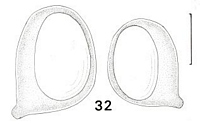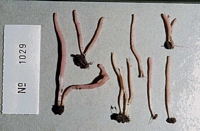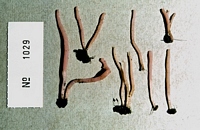|
 Clavaria roseoviolacea Clavaria roseoviolacea
BiostatusPresent in region - Indigenous. Endemic
Images (click to enlarge)
Caption: Fig. 32 Clavaria roseo-violacea, spores. Horak no. 1029 (zt). Scale bar=5 µm | 
Caption: Microfiche 1-24. Clavaria roseo-violacea. Horak no. 1029. | 
Caption: 1029, id. R. Petersen, label 50x10mm, NZ, NI, Auckland, Waitakere R., Huia, Karamatura Stream, on soil in
broadleaf-conifer forest, 01.07.1981, leg. EH
Owner: E. Horak |
Article: Petersen, R.H. (1988). The clavarioid fungi of New Zealand. New Zealand Department of Scientific and Industrial Research, Bulletin 236: 170 pp. Wellington:.
Description: Fruit bodies up to 70 x 4.5 mm, simple clubs, narrowly fusiform, cespitose in groups from 8
to 30, arising from individual or common whitish mycelial patches, fragile. Club violaceous
rose ("alizarine-pink" to "deep vinaceous") to buffy pink ("grenadine-pink", "light Congo-pink"), darkening somewhat in age ("light
Corinthian-red", "jasper-pink"), opaque, appearing
waxy, equal or tapering slightly upward; apex rounded; flesh white, stuffed. Stipe striate-silky, paler than club ("light Congo-pink",
"Chatenay-pink" to "Venetian-pink"), clearly
delimited from hymenium. Taste and odour negligible.
Tramal hyphae 3-8 µm diam., hardly inflated, thin-walled, clampless, strictly parallel,
adherent; secondary septa abundant. Subhymenium well-developed, pseudoparenchymatous.
Hymenium thickened, agglutinated; basidia 40-50 x 9-11 µm, clavate, clamped to
asymmetrically bifurcate, refringent, empty but persistent after spore discharge; sterigmata 4,
up to 7 µm long, stout, subcornute.
Spores (Fig. 32) 7.9-10.8 x 6.5-7.9 µm (E = 1.19-1.33; Em = 1.27; Lm = 8.93 µm),
subglobose, to broadly ellipsoid, smooth, thin-walled; contents homogeneous or with 1-2
guttules; hilar appendix papillate, broad.
Notes: In general shape and colour, this taxon resembles Clavaria rubicundula from North
America, which produces fascicles of simple clubs. In C. roseo-violacea, however, fruit
bodies are not truly fasciculate, but densely cespitose, and do not originate below the
substrate level as do those of C. rubicundula, but from mycelial patches on the substrate
surface. Finally, C. rubicundula belongs in subg. Clavaria.
Previously, I reported on the type specimen of Clavaria miltina Berk. (Petersen 1967b), to which C. roseo-violacea could be
compared. Because material of that type was so poor, I decided to discard the epithet as a nomen dubium. Moreover, my observations indicated
that tramal hyphae were clamped, so that taxon was removed from subg. Holocoryne, if not from
Clavaria.
Fruit body colour is very suggestive of descriptions of Clavaria incarnata of the North Temperate Zone. That species concept differs
from C. roseo-violacea in producing elongate spores (6-10 x 3.5-6.5 µm) and solitary to scattered fruit bodies.
|